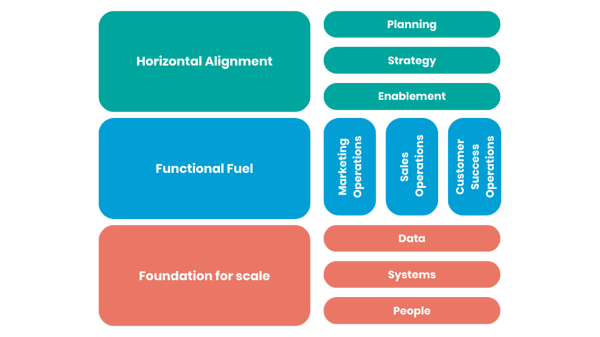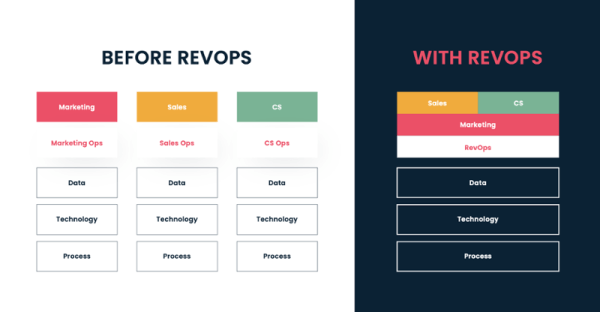






Are you looking to grow your business revenue? Perhaps you've heard of RevOps and are wondering if it can help you achieve your goal. In this comprehensive article, we will provide you with an overview of RevOps, its key components, benefits, and best practices for implementation. Whether you're a startup or an established organisation, read on to discover how RevOps can transform your business.
Understanding RevOps: A Comprehensive Overview
Revenue Operations, also known as RevOps, is a term coined to describe a holistic approach to aligning sales, marketing, and customer success teams into a single, cohesive revenue-generating unit. It's a strategic approach to optimising customer engagement and streamlining operations by eliminating silos and aligning processes that support revenue objectives.
Defining Revenue Operations (RevOps)
RevOps is a concept that has gained popularity in recent years. It refers to the integration of sales, marketing, and customer success teams into a single, cohesive revenue-generating unit. The purpose of RevOps is to optimise customer engagement and streamline operations by aligning processes that support revenue objectives. By eliminating silos and aligning processes, RevOps helps companies to achieve business growth.
RevOps is a strategic approach that involves aligning your revenue-generating processes, tools, and technologies. It's a holistic approach that requires collaboration and coordination across different departments to achieve a common goal.

The Evolution of RevOps
The traditional sales and marketing functions faced growing challenges because of their siloed approach. As businesses became more complex and customer expectations evolved, the need to improve collaboration and coordination across different departments prompted the emergence of a new functional area that would focus on aligning revenue-generating activities across teams: RevOps.
RevOps evolved from the collaboration between SalesOps and MarketingOps teams. SalesOps and MarketingOps were created to optimise the sales and marketing functions, respectively. However, these functions were still siloed, and there was a need to align them to achieve a common goal. This led to the emergence of RevOps, which integrates sales, marketing, and customer success teams into a single, cohesive revenue-generating unit.
Key Components of RevOps
Revolving around people, process, and technology, the key components of RevOps include:
- Alignment of Sales, Marketing, and Customer Success: RevOps aligns sales, marketing, and customer success teams to achieve a common goal. By aligning these teams, companies can optimise customer engagement and streamline operations.
- Visibility and Transparency: RevOps provides visibility and transparency into the revenue-generating processes. This helps companies to identify areas for improvement and make data-driven decisions.
- Sales and Marketing Analytics: RevOps relies on data to optimise revenue-generating processes. By analysing sales and marketing data, companies can identify trends and make data-driven decisions.
- Automation and Technology: RevOps relies on automation and technology to streamline revenue-generating processes. By automating repetitive tasks, companies can increase efficiency and reduce errors.
- Cross-functional Collaboration and Communication: RevOps requires collaboration and communication across different departments. By breaking down silos and promoting collaboration, companies can optimise revenue-generating processes.
RevOps is a strategic approach that requires collaboration and coordination across different departments. By aligning sales, marketing, and customer success teams into a single, cohesive revenue-generating unit, companies can optimise customer engagement and streamline operations. RevOps is a holistic approach that involves people, process, and technology to achieve a common goal.
The Benefits of Implementing RevOps in Your Business
RevOps, or Revenue Operations, is a business strategy that aligns sales, marketing, and customer success teams towards a common revenue goal. By implementing RevOps, businesses can achieve several benefits that can help them to grow and succeed in today's competitive landscape.
Streamlining Processes and Increasing Efficiency
One of the primary benefits of implementing RevOps is the ability to eliminate redundancies and streamline processes. By doing so, businesses can save time and reduce costs, which can lead to improved sales cycles and ROI. RevOps enables teams to work faster and more efficiently, which can result in improved productivity and a more agile business model.
For example, by using automation tools and workflows, businesses can reduce the time and effort required to complete repetitive tasks. This can free up team members to focus on more strategic activities, such as building relationships with customers or developing new products.
Aligning Sales, Marketing, and Customer Success Teams
RevOps also helps to align sales, marketing, and customer success teams towards a common revenue goal. By doing so, businesses can provide a seamless experience for customers as they move through the buying cycle. This can result in higher conversion rates and increased customer satisfaction.
For example, by aligning sales and marketing teams, businesses can ensure that they are targeting the right customers with the right messaging. This can help to improve lead quality and increase the likelihood of a successful sale. Similarly, by aligning customer success teams with sales and marketing, businesses can ensure that they are providing the right level of support to customers throughout their journey.
Improving Data-Driven Decision Making
RevOps provides a centralised data repository, which enables teams to analyse data across multiple channels, identify trends, and make data-driven decisions that drive revenue growth. This leads to improved forecasting accuracy and better decision-making at every level of the organisation.
For example, by analysing customer data, businesses can identify patterns and trends that can help them to improve their products and services. They can also use data to identify areas where they need to improve their sales and marketing efforts, such as targeting new customer segments or improving their messaging.
Enhancing Customer Experience and Retention
RevOps enables teams to gain a deep understanding of their customers' needs. This results in personalised communications, better product offerings, and an overall improved customer experience. The result is increased customer loyalty and retention.
For example, by using customer data to personalise communications, businesses can improve their relationships with customers and increase the likelihood of repeat business. They can also use customer feedback to improve their products and services, which can help to increase customer satisfaction and loyalty.
In conclusion, implementing RevOps can provide several benefits to businesses, including streamlined processes, aligned teams, improved data-driven decision-making, and enhanced customer experience and retention. By adopting this strategy, businesses can position themselves for success in today's competitive landscape.
The RevOps Framework: Key Elements and Best Practices
Revenue Operations (RevOps) is a strategy that enables organisations to align their sales, marketing, and customer success departments to drive revenue growth. It involves breaking down silos between departments and creating a cohesive unit that works towards achieving a common revenue goal. RevOps is a relatively new concept, but it has gained traction in recent years due to its effectiveness in driving revenue growth and improving the customer experience.
Aligning Goals and Objectives Across Departments
One of the key elements of RevOps is aligning goals and objectives across departments. By doing so, organisations can create a unified team that works towards achieving a common revenue goal. This helps to eliminate silos and promotes cross-functional communication and collaboration across departments. When departments work together towards a common goal, they can achieve better results than when they work independently.
For example, a company's sales team might be focused on closing deals, while the marketing team is focused on generating leads. By aligning their goals and objectives, the sales team can provide feedback to the marketing team on the quality of leads they receive, and the marketing team can adjust their strategy accordingly. This helps to ensure that the leads generated by the marketing team are of high quality and have a higher chance of converting into sales.
Implementing Effective Communication and Collaboration
Effective communication and collaboration are critical components of RevOps. When departments work together, they can share insights and collaborate to provide a unified customer experience that meets the customer's expectations. This helps to reduce misunderstandings and improve transparency, which benefits everyone involved.
For example, a customer might have an issue with a product they purchased. The customer success team can work with the sales and marketing teams to identify the root cause of the issue and provide a solution that meets the customer's needs. By working together, the teams can provide a seamless customer experience that increases customer satisfaction and loyalty.
Leveraging Technology and Automation
The use of technology and automation tools is critical in RevOps. Implementing automation tools can help streamline repetitive processes, save time, and enhance accuracy. Advanced analytics tools can help teams to analyse data and make data-driven decisions that drive revenue growth.
For example, a company might use a customer relationship management (CRM) system to track customer interactions and sales data. The sales team can use this data to identify trends and make data-driven decisions about their sales strategy. This can help them to identify which products are selling well and which ones need improvement.
Establishing Metrics and KPIs for Success
Success metrics and key performance indicators (KPIs) are critical in RevOps. By establishing metrics and KPIs, organisations can track their progress and measure their success. This enables teams to continuously improve their processes and adjust their tactics to achieve optimal results.
For example, a company might establish a KPI for customer retention. The customer success team can track customer retention rates and identify areas where they can improve. By doing so, they can reduce customer churn and increase revenue growth.
Overall, the RevOps framework is an effective strategy for driving revenue growth and improving the customer experience. By aligning goals and objectives, implementing effective communication and collaboration, leveraging technology and automation, and establishing metrics and KPIs for success, organisations can achieve optimal results and stay ahead of the competition.
Building a Successful RevOps Team
Key Roles and Responsibilities in a RevOps Team
Building a successful RevOps team requires the right mix of talent and skills. Key roles and responsibilities in a RevOps team include Revenue Operations Manager, Sales Operations Manager, Marketing Operations Manager, and Customer Success Operations Manager. Each of these roles plays a critical part in the success of a RevOps team.

Essential Skills and Qualifications for RevOps Professionals
RevOps requires a unique skill set that includes high-level strategic thinking, technical proficiency, and strong communication skills. RevOps professionals must have a deep understanding of sales, marketing, and customer success. They should also be experienced with technology and data analytics tools.
Fostering a RevOps Culture within Your Organisation
RevOps is not just a functional area within an organisation but also a culture. Building a RevOps culture requires continuous engagement and collaboration across different departments. Leaders within the organisation should communicate the value of RevOps to ensure all teams are invested in the success of this function.
Wrapping up
RevOps is a strategic approach to revenue generation that can help your business achieve growth and success. By aligning your sales, marketing, and customer success teams, implementing effective communication and collaboration, leveraging technology, and establishing metrics for success, RevOps can transform your business. Building a successful RevOps team requires the right mix of talent, skills, and culture. Consider implementing a RevOps strategy today to grow your business and achieve your revenue objectives.
You can read more on our What is RevOps? page.









